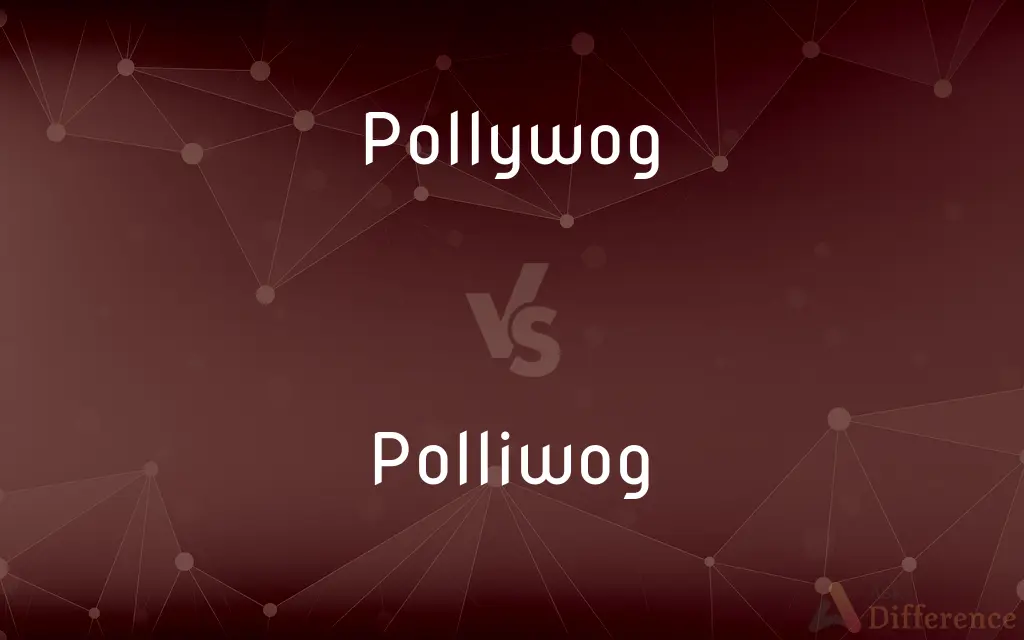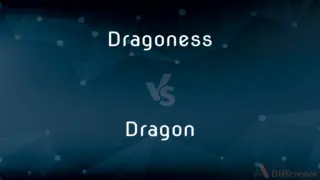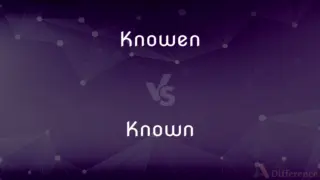Pollywog vs. Polliwog — What's the Difference?
By Fiza Rafique & Maham Liaqat — Updated on April 4, 2024
A pollywog and a polliwog both refer to the larval stage of a frog or toad, differing only in spelling variations across regions.

Difference Between Pollywog and Polliwog
Table of Contents
ADVERTISEMENT
Key Differences
Pollywog and polliwog both describe the tadpole stage of amphibians, focusing on the period before they develop into elder frogs or toads. While "pollywog" is one variation, "polliwog" serves as an alternative spelling, with no distinction in meaning or usage.
Both terms are used colloquially and scientifically to discuss the same developmental stage, where the creature is aquatic, breathes through gills, and has not yet developed legs. However, the choice between "pollywog" and "polliwog" may reflect regional preferences, with some areas or communities favoring one spelling over the other.
In literature and education, both terms are equally accepted, and the choice between them often comes down to personal or editorial preference. Whereas, in scientific contexts, the term "tadpole" is more commonly used, but "pollywog" and "polliwog" still find their place in less formal discussions or in efforts to engage a younger audience.
Despite the differences in spelling, both terms evoke the same images of a small, wriggling creature in its early life stage, fascinating to both children and youngs alike for their transformational journey from water to land. This shared imagery underlines the interchangeable use of "pollywog" and "polliwog" in most contexts, emphasizing their role in educational and cultural narratives about amphibians.
Comparison Chart
Definition
A tadpole, the larval stage of frogs and toads.
A tadpole, the larval stage of frogs and toads.
ADVERTISEMENT
Spelling Variation
Pollywog is one common spelling.
Polliwog is an alternative spelling.
Usage
Used interchangeably with polliwog.
Used interchangeably with pollywog.
Regional Preference
Some regions may prefer "pollywog."
Some regions may prefer "polliwog."
Context
Can be used in both scientific and colloquial contexts.
Can be used in both scientific and colloquial contexts.
Imagery
Evokes the image of a tadpole swimming in water.
Evokes the image of a tadpole swimming in water.
Educational Use
Frequently used to teach children about amphibian life cycles.
Frequently used to teach children about amphibian life cycles.
Scientific Terminology
Less formal than "tadpole," but still accurate.
Less formal than "tadpole," but still accurate.
Compare with Definitions
Pollywog
A larval frog or toad, living in water and breathing through gills.
The pond was teeming with pollywogs in early spring.
Polliwog
Another spelling for the larval stage of amphibians, especially frogs and toads.
We spotted several polliwogs near the riverbank.
Pollywog
Also known as a tadpole during its developmental stage.
Children love watching pollywogs grow into frogs.
Polliwog
Identical in meaning to "pollywog," it describes a tadpole.
The nature guide explained how polliwogs breathe through gills.
Pollywog
A term used in education to describe amphibian larvae.
The science teacher showed the students a jar of pollywogs.
Polliwog
Often used in storytelling to illustrate change.
The polliwog in the fable learned about courage and transformation.
Pollywog
Reflects a stage of metamorphosis from water to land dwelling.
Pollywogs undergo a fascinating transformation during their growth.
Polliwog
Used in both casual and educational language about amphibians.
The biology textbook includes a section on polliwogs.
Pollywog
Can signify growth and transformation in cultural stories.
The story used a pollywog to symbolize personal growth.
Polliwog
Symbolizes the early life stage of an amphibian before it becomes terrestrial.
Polliwogs have tails, which they lose as they mature.
Pollywog
Variant of polliwog.
Polliwog
See tadpole.
Pollywog
A person of Polynesian (usually Samoan) descent.
Polliwog
A tadpole.
Pollywog
A polliwig.
Polliwog
A larval frog or toad
Pollywog
A larval frog or toad
Common Curiosities
How do pollywogs transform into frogs?
They undergo metamorphosis, developing legs and lungs to adapt to a terrestrial life.
Can pollywogs and polliwogs breathe underwater?
Yes, they breathe through gills while in their larval stage.
Are pollywog and polliwog the same thing?
Yes, they refer to the same larval stage of frogs and toads.
Which term is more scientifically accurate, pollywog or polliwog?
Scientifically, "tadpole" is more commonly used, but both pollywog and polliwog are correct.
How long does it take for a pollywog to turn into a frog?
The time varies by species but can range from a few months to three years.
Can pollywogs and polliwogs be kept as pets?
While possible, they require specific care to mimic their natural habitat and diet.
How do temperature and environment affect pollywog development?
Warmer temperatures generally speed up development, while colder conditions can slow it down.
Where can pollywogs or polliwogs be found?
They are found in aquatic environments like ponds, lakes, and slow-moving streams.
Are there any diseases that affect pollywogs?
Yes, they can be affected by fungal and parasitic infections, among other diseases.
Do all frogs and toads start as pollywogs/polliwogs?
Yes, all frogs and toads begin their life cycle as tadpoles or pollywogs/polliwogs.
What do pollywogs eat?
They primarily feed on algae and plant material in the water.
Is there a difference in the way pollywog and polliwog are used?
No, the terms are used interchangeably, with the choice often down to regional preference.
Do pollywogs have any natural predators?
Yes, they are preyed upon by birds, fish, and other aquatic creatures.
Why are pollywogs important to ecosystems?
They are a key food source for many predators and play a role in aquatic ecosystems.
Why do pollywogs lose their tails as they mature?
The tail is reabsorbed to provide nutrients for the growing frog or toad, as it transitions to a terrestrial lifestyle.
Share Your Discovery

Previous Comparison
Dragoness vs. Dragon
Next Comparison
Knowen vs. KnownAuthor Spotlight
Written by
Fiza RafiqueFiza Rafique is a skilled content writer at AskDifference.com, where she meticulously refines and enhances written pieces. Drawing from her vast editorial expertise, Fiza ensures clarity, accuracy, and precision in every article. Passionate about language, she continually seeks to elevate the quality of content for readers worldwide.
Co-written by
Maham Liaqat














































